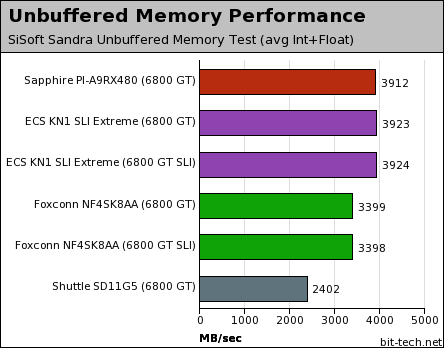
Testing Methods:
After a recent editorial, we have decided to change the way we review motherboards here at bit-tech. We've moved our focus away from synthetic benchmarks that provide meaningless numbers from scenarios the consumer rarely finds themselves in.With the exception of SiSoft Sandra's unbuffered memory bandwidth benchmark - which, incidentally, measures real memory bandwidth when you need it most - all of our benchmarks have been engineered to give you numbers that you are likely to find useful when actually using the products we have evaluated in the real world. There are plans to increase the number of benchmarks over time and we're running additional tests that will not be published until we have enough products to make a reasonable comparison.
We are also focusing a lot more of our time on evaluating the stability of the motherboards (and platforms) using a stress test designed to highlight any of the potential weaknesses that the product may have. That involves a gradually increasing amount of stress starting with Prime95 and expanding to IOMeter and 3DMark03 if all is well. This is to ensure that all parts of the system are stressed simultaneously over a period of time.
We believe that the consumer is never likely to subject their platform to this level of stress and we are not expecting every product to complete an entire extended stress test. However, most poorly engineered products fail within the first couple of hours, or even minutes, allowing us to make a conscious decision on whether a motherboard (or platform) is worth your money, regardless of how well it performs in our benchmarks.
Test Setup:
AMD Athlon 64 4000+ (operating at 2400MHz - 12x200); Sapphire PI-A9RX480; 2 x 512MB Corsair 3200XL Pro (operating in dual channel with 2.0-2-2-5-1T timings); NVIDIA GeForce 6800 GT (operating at 350/1000MHz); Western Digital 74GB Raptor 10,000RPM SATA 150 Hard disk drive; Windows XP Professional Service Pack 2; DirectX 9.0c; NVIDIA ForceWare 71.89 WHQL.AMD Athlon 64 4000+ (operating at 2400MHz - 12x200); ECS KN1 SLI Extreme; 2 x 512MB Corsair 3200XL Pro (operating in dual channel with 2.0-2-2-5-1T timings); NVIDIA GeForce 6800 GT (operating at 350/1000MHz); Western Digital 74GB Raptor 10,000RPM SATA 150 Hard disk drive; Windows XP Professional Service Pack 2; DirectX 9.0c; NVIDIA ForceWare 71.89 WHQL.
AMD Athlon 64 4000+ (Clawhammer, 1MB L2); Foxconn WinFast NF4SK8AA-8EKRS (NVIDIA NForce 4 SLI); 2 x 512MB Corsair 3200XL Pro (operating at 400MHz with 2.0-2-2-5-1T timings); NVIDIA GeForce 6800 GT (operating at 350/1000MHz); Western Digital Raptor 74GB; Windows XP Professional Service Pack 2; DirectX 9.0c; NVIDIA ForceWare 71.89 WHQL.
Intel Pentium M 2.13GHz (133x16, 2MB L2); Shuttle SD11G5; 2 x 512MB Corsair 5400UL DDR2 (operating at 533MHz in dual channel with 3.0-2-2-8 timings); NVIDIA GeForce 6800 GT (operating at 350/1000MHz); Western Digital Raptor 74GB; Windows XP Professional Service Pack 2; DirectX 9.0c; NVIDIA ForceWare 71.89 WHQL, Intel Inf 7.00.1.
Memory Performance:

Stability & Overclocking:
215MHz x11.5 completely stable in SuperPi, but over that up until 220MHz, despite lowering memory timings and increasing voltages getting into the OS would cause CPU-Z to show stock speeds. At 220MHz the system failed to boot, so we checked the failed boot reset settings option where, after a set number of failed boot ups, it resets itself to stock speeds. That BIOS setting worked, we recommend setting it to 1 or 2 as to subject the system to as few on/off cycles as required.General stability at stock speeds through extended testing with simultaneous instances of Prime95 and I/Ometer in the background, along with continuous loops of a FarCry 1.3 timedemo was flawless. We found that this board is rock solid stable, as you'd expect from something doubly checked by Sapphire and ATI.

MSI MPG Velox 100R Chassis Review
October 14 2021 | 15:04






Want to comment? Please log in.